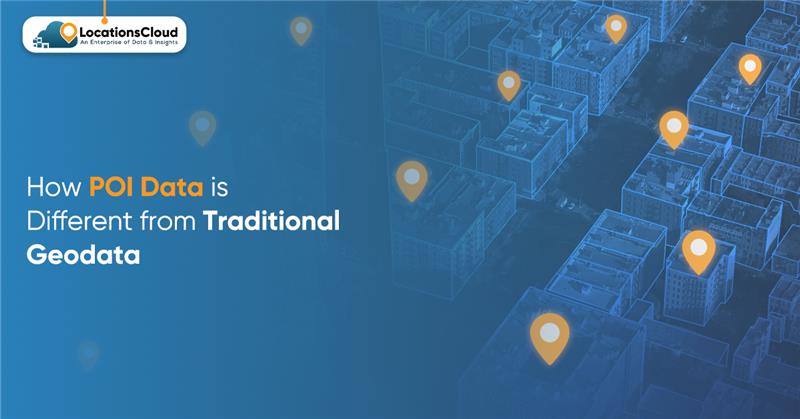
Location intelligence has become crucial for businesses across industries. However, many organizations struggle to understand the fundamental differences between Point of Interest (POI) data and traditional geodata. This confusion can lead to poor decision-making and missed opportunities.
In this comprehensive guide, we will explore how POI data differs from conventional geographic information. You willl learn when to use each type and how LocationsCloud delivers accurate, actionable location intelligence for your business needs.
What is Traditional Geodata?
Traditional geodata refers to raw geographic information about the Earth’s surface. It includes coordinates, boundaries, elevations, and physical features. Think of it as the foundation of all location-based information.
Geodata typically encompasses several key elements. First, it includes coordinate systems that define specific points on Earth using latitude and longitude. Second, it contains boundary data such as country borders, state lines, and city limits. Third, it features topographic information like mountains, rivers, and valleys.
Moreover, traditional geodata often comes from government surveys and satellite imagery. Organizations like the USGS in the United States maintain vast repositories of this information. The data is precise and scientifically verified, making it ideal for mapping and navigation.
However, geodata alone doesn’t tell you much about human activity. It shows where places are located but not what happens there. This limitation becomes apparent when businesses need to understand customer behavior or market opportunities.
Understanding POI Data
Point of Interest data represents specific locations where people conduct activities. These are real-world places that matter to businesses and consumers alike. POI data goes beyond simple coordinates to describe what exists at each location.
A POI database contains rich information about each place. This includes the business name, complete address, and accurate coordinates. Additionally, it features category classifications, operating hours, and contact information. Many POI datasets also include customer ratings, photos, and detailed descriptions.
LocationsCloud specializes in providing comprehensive POI datasets that help businesses make smarter decisions. Our platform aggregates data from multiple verified sources to ensure accuracy and completeness.
Furthermore, POI data is dynamic and constantly evolving. New businesses open, others close, and details change regularly. Therefore, maintaining current POI information requires ongoing updates and verification processes.
Key Differences Between POI Data and Traditional Geodata
The distinction between these two data types becomes clearer when we examine their characteristics side by side. Let’s explore the primary differences that matter most to businesses.
Purpose and Application
Traditional geodata serves primarily for mapping and navigation purposes. Surveyors use it to create accurate maps. Engineers rely on it for infrastructure planning. Scientists analyze it to understand geological patterns.
In contrast, POI data drives business intelligence and customer engagement. Retailers use it to identify expansion opportunities. Marketers leverage it for targeted advertising campaigns. Delivery services depend on it for route optimization.
Data Attributes and Richness
Geodata focuses on physical characteristics. It tells you the exact elevation of a mountain or the precise boundary of a lake. The information is scientific and measurable.
Meanwhile, POI data provides business-relevant attributes. LocationsCloud delivers detailed information about each location, including business categories, amenities, and customer preferences. This richness enables more sophisticated analysis and decision-making.
Update Frequency and Maintenance
Traditional geodata changes slowly. Mountain ranges don’t move overnight. Political boundaries shift infrequently. Therefore, geodata updates happen on longer cycles, sometimes annually or even less frequently.
However, POI data requires continuous maintenance. Businesses relocate, change hours, or close permanently. New establishments open every day. LocationsCloud maintains fresh POI data through regular verification and updates, ensuring our clients always work with current information.
Source and Collection Methods
Geodata typically comes from official government agencies and satellite imagery. The collection methods are standardized and scientifically rigorous. Accuracy is paramount, and verification follows strict protocols.
Conversely, POI data originates from diverse sources. These include business registrations, crowdsourced contributions, on-ground verification, and web scraping. LocationsCloud combines multiple data sources to create comprehensive, accurate POI datasets that businesses can trust.
Granularity and Detail Level
Geodata operates at various scales, from global to local. Yet the information remains relatively uniform. A coordinate is a coordinate, whether it represents a country’s center or a specific street corner.
On the other hand, POI data varies significantly in detail. Some locations require extensive information—restaurants need menus, hours, and cuisine types. Other POIs need different attributes entirely. LocationsCloud customizes data fields based on industry requirements and use cases.
Why POI Data Matters for Modern Businesses?
The business landscape has shifted dramatically with digital transformation. Companies now compete on their ability to understand and reach customers precisely. This is where POI data becomes invaluable.
Location-Based Marketing
Traditional geodata tells you where neighborhoods exist. POI data tells you where your customers actually go. This distinction is critical for targeted marketing campaigns.
For example, a coffee chain can use LocationsCloud POI data to identify high-traffic areas lacking nearby competitors. They can analyze foot traffic patterns, demographic information, and complementary businesses in each location. This intelligence leads to better site selection and higher ROI.
Competitive Intelligence
Understanding your competitive landscape requires more than knowing where competitors are located. You need to know what they offer, their operating hours, and their customer ratings.
LocationsCloud provides comprehensive competitor POI data that helps businesses benchmark their performance. You can track new market entrants, monitor competitor expansion, and identify underserved markets. These insights are impossible to obtain from traditional geodata alone.
Customer Experience Enhancement
Modern consumers expect personalized, location-aware experiences. They want recommendations based on their current location and preferences. This requires detailed POI information integrated into your applications.
By leveraging LocationsCloud POI data, businesses can build sophisticated location-based services. These include store locators, proximity searches, and personalized recommendations. The result is improved customer satisfaction and increased engagement.
Supply Chain Optimization
Logistics companies need more than maps to operate efficiently. They require detailed information about delivery destinations, including access restrictions, operating hours, and special requirements.
POI data enables smarter route planning and resource allocation. LocationsCloud helps logistics providers optimize their operations by providing accurate, detailed information about every delivery point. This reduces costs and improves service levels.
How LocationsCloud Bridges the Gap?
Understanding the difference between POI data and traditional geodata is just the beginning. The real challenge is accessing high-quality data that drives results.
LocationsCloud specializes in providing enterprise-grade POI data that businesses can rely on. Our platform combines the precision of traditional geodata with the richness of business intelligence. We verify every data point through multiple sources and maintain continuous updates.
Comprehensive Coverage
We don’t just cover major cities or popular chains. LocationsCloud provides POI data across regions, categories, and business types. Whether you need restaurant data, retail locations, or healthcare facilities, we deliver comprehensive coverage.
Verified Accuracy
Data quality matters more than quantity. Therefore, LocationsCloud implements rigorous verification processes. We cross-reference multiple sources, conduct regular audits, and update information continuously. This ensures you make decisions based on accurate, current data.
Customizable Datasets
Every business has unique requirements. LocationsCloud offers flexible data solutions tailored to your specific needs. You can filter by category, region, or custom attributes. We also provide API access for seamless integration with your existing systems.
Practical Use Cases Across Industries
Different industries leverage POI data in unique ways. Let’s examine how various sectors benefit from understanding the distinction between POI data and traditional geodata.
Retail and E-commerce
Retailers use LocationsCloud POI data for site selection and market analysis. They identify gaps in coverage, assess competitor proximity, and evaluate demographic fit. E-commerce companies leverage it for last-mile delivery optimization and pickup point selection.
Real Estate
Property developers need to understand the surrounding area when evaluating locations. POI data reveals nearby amenities, commercial activity, and development potential. LocationsCloud helps real estate professionals make informed investment decisions.
Financial Services
Banks and insurance companies use POI data for risk assessment and market penetration strategies. They analyze business density, economic activity, and demographic patterns. This intelligence guides branch placement and product development.
Hospitality and Travel
Hotels and travel platforms depend on POI data to enhance guest experiences. They provide recommendations for nearby restaurants, attractions, and services. LocationsCloud enables these businesses to offer value-added services that differentiate their offerings.
Choosing the Right Data for Your Needs
Now that you understand the differences, how do you choose the right data type? The answer depends on your specific use case and objectives.
If you are building navigation systems or conducting geographic analysis, traditional geodata serves as your foundation. However, if you’re making business decisions, targeting customers, or analyzing market opportunities, POI data is essential.
Most modern applications actually require both types of data working together. The geodata provides the framework, while POI data adds the business intelligence layer. LocationsCloud delivers integrated solutions that combine both, giving you a complete picture.
The Future of Location Intelligence
Location data continues evolving rapidly. Traditional geodata and POI data are converging into more sophisticated location intelligence platforms. Real-time updates, predictive analytics, and AI-driven insights are becoming standard.
LocationsCloud stays at the forefront of these developments. We continuously enhance our data quality, expand coverage, and introduce new capabilities. Our goal is to provide businesses with the most comprehensive, accurate, and actionable location intelligence available.
Furthermore, privacy regulations and data governance are shaping how location data is collected and used. LocationsCloud maintains strict compliance with all relevant regulations while delivering the insights businesses need.
Making Location Intelligence Work for You
Understanding the difference between POI data and traditional geodata is crucial for leveraging location intelligence effectively. Traditional geodata provides the geographic foundation, while POI data adds the business context that drives decisions.
LocationsCloud combines both into powerful, actionable intelligence. Our platform delivers verified, current, and comprehensive POI data that helps businesses across industries achieve their objectives. Whether you’re expanding into new markets, optimizing operations, or enhancing customer experiences, we provide the location intelligence you need.
Ready to transform your location strategy? Visit LocationsCloud today to explore our comprehensive POI datasets and discover how accurate location intelligence can drive your business forward. Our team of experts is ready to help you unlock the full potential of location data for your specific needs.
Unlock the Power of POI Data
Discover how POI data goes beyond maps to reveal deeper business insights.


